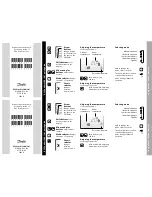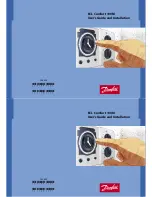
09 SAFETY NOTES
HANDBOOK_
SAFETY NOTES_
89
First check the following circumstances:
- Does the actuator the required version ( torque, protection, voltage, swivel angle, etc.).
- Does the wiring acc. to the voltage (see diagram/type label).
- Is it possible to adjust the valve on the manual override.
- Switch from AUTO to MAN, move the handwheel/ handlever to synchronize the transmission then exit the adjust
-
ment path manually and turn back to the starting position. Then switch from MAN to AUTO and move the handlever/
hand wheel onesmore.
These safety instructions are to be considered by any person concerned with the operation, maintenance or repair of
the actuators. The proper and safe operation requires proper transport, proper storage, mounting and careful operation.
- Maintenance and repair work may only be performed by qualified personnel. When wiring electrical equipment the
applicable VDE and EVU regulations are observed.
- Electrical protection measures (grounding resistance, etc.) are to be checked.
- When working on the actuator or connected to these devices and system components, the supply voltage must be
switched off.
- Perform the installation, repair work in compliance with the applicable statutory and professional safety and accident
prevention regulations!
- The safety aspects are always depending on the circumstances and the timing of the assembly, disassembly, adjust
-
ment, commissioning and are therefore always to adapt to the application.
Mounting:
- Switch off all equipment, machinery, equipment which is affected by the installation or repair and disconnect the
equipment, machinery, plant, where appropriate, from the net!
Check whether the plant shut-down causes potential danger ! Inform the shift foreman, safety engineer or the
conductor immediately to prevent a fault in the actuator, by run out or spilling of liquids or leakage of gases, with
suitable measures!
- Check the correct function of the safety devices (e.g. Emergency-Stop-Switch/Safety valves etc.)!
- Provide for adequate vibration isolation! Vibrations can cause damage depending on the type or resonance with the
actuator components. Be particularly sensitive to wearing parts such as potentiometers, motors or electronic
components. The use in vibration-prone environments has to be coordinated with the actuator manufacturer.
- When installed in wet environments and in areas with significant temperature changes in each case the built-in
control room heater has to be kept actively after the actuator is stopping in the end position.
- Fireplaces, stoves, direct sunlight and other heat sources can emit large amounts of energy.
This heat radiation should be avoided by appropriate shielding of the actuator.
Setting and Commissioning:
-
Make sure that the starting or the test settings on the actuator, no potential hazards to personnel or the environment.
- If necessary, set up warning signs, so that unintentional operation is prevented.
- During commissioning of the electric part turn actuator manually or electrically, the position of an attached valve is
changed. This allows the flow of gases, vapours, liquids, etc. are enabled or interrupted.
- Check that the valve is actually closed 100 percent when the controller signals the corresponding position!
- Avoid being trapped by suitable measures that by moving parts limbs.
- The actuator may be used only for the purpose it was designed.
- Open the electric rotary actuator only so far as it is described in this documentation.
- Before mounting the actuator is the ease of movement of the actuator to consider.
- All cables that are to be connected to the supply, before the electrical installation.
- Upon completion of maintenance or repair, check the correct function and possibly adhering to the target angular
position of the actuator and the function of the adjusted to the angular positions switch.
- To clean the housing, do not use abrasive, corrosive or flammable cleaners or high-pressure cleaning equipment.
Summary of Contents for J4C B140
Page 1: ...www jjbcn com HANDBOOK J J BCN INTERNACIONAL S A...
Page 12: ...HANDBOOK_J4C SERIES 12 INDEX TABLE OF CONSUMPTIONS...
Page 13: ...HANDBOOK_J4C SERIES 13 INDEX TABLE OF CONSUMPTIONS...
Page 18: ...J4C 20 SIZES HANDBOOK_DATASHEET J4C 20 _18 INDEX...
Page 23: ...J4C 35 SIZES HANDBOOK_DATASHEET J4C 35 _23 INDEX...
Page 28: ...J4C 55 SIZES HANDBOOK_DATASHEET J4C 55 _28 INDEX...
Page 33: ...J4C 85 SIZES INDEX HANDBOOK_DATASHEET J4C 85_33...
Page 35: ...Exploded View HANDBOOK_DATASHEET J4C 85_35 INDEX...
Page 38: ...J4C 140 SIZES INDEX HANDBOOK_DATASHEET J4C 140_38...
Page 43: ...J4C 300 SIZES HANDBOOK_DATASHEET J4C 300_43 INDEX...
Page 50: ...SPECIFICATIONS INDEX DPS J4C 140 300 HANDBOOK_Optios DPS_50 F S Full scale...
Page 53: ...OPTIONS BSR BSR J4C 20 85 HANDBOOK_Optios BSR_53 SPECIFICATIONS INDEX...
Page 55: ...BSR J4C 140 300 HANDBOOK_Optios BSR_55 SPECIFICATIONS INDEX...
Page 60: ...ASSEMBLY INSTRUCTIONS HANDBOOK_KIT DPS_60 INDEX...
Page 64: ...ASSEMBLY INSTRUCTIONS HANDBOOK_KIT DPS_64 INDEX...
Page 67: ...ASSEMBLY INSTRUCTIONS HANDBOOK_KIT BSR_67 INDEX...
Page 70: ...ASSEMBLY INSTRUCTIONS HANDBOOK_KIT BSR_70 INDEX...
Page 81: ......
Page 82: ......
Page 83: ......
Page 84: ......
Page 85: ......
Page 86: ......



































